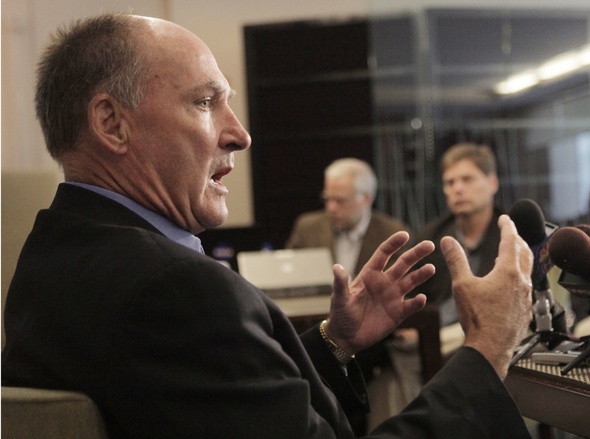Big Ten expansion presses on, ramifications could be enormous

Big Ten commissioner Jim Delany talks with the media during a news conference, Tuesday, May 18, 2010, in Chicago. Delany addressed questions about conference expansion, sticking with the time frame he laid out in December when he said the league would explore its option over the next 12 to 18 months.
AP photo
CHICAGO - According to one school of thought, Big Ten expansion will start a chain reaction that will change the face of college sports.
The Big Ten will grow to 16 teams by raiding the Big East and Big 12 for new members. The SEC will add four teams to keep pace, the ACC will swallow what’s left of the Big East, and the Pac-10 and Big 12 will merge into one. The result: Four super-conferences will run the NCAA.
Big Ten commissioner Jim Delany doesn’t buy it.
“I know a lot has been written about that, but I don’t think that necessarily follows at all,” Delany said. “I think it’s like saying everybody’s going to go to a 12-team conference. We didn’t. Somebody went to a 16-team conference, the Big East. Somebody else stayed at 10 (the Pac-10). We stayed at 11.
“I don’t necessarily see why if one group does something it thinks is in its best interests, that somebody else would imitate it. Unless there were good reasons to imitate it.”
Delany said Tuesday at the Big Ten spring meetings that the profitable Big Ten Network - “a gold mine,” Illinois coach Ron Zook called it - and a population shift out of the Midwest are driving the conference’s push for expansion.
While those reasons are somewhat unique, Neil Pilson, the former president of CBS Sports, said last week a 14- or 16-team Big Ten “would cause an enormous amount of pain and controversy within the college sports community” and eventually lead conference officials to “Washington to explain what they did to congressmen and senators.”
“If they go add one more member, everybody understands, nobody will say anything. There’ll be some minor adjustments and that’ll be the end of it,” Pilson said. “If they go to 14 or 16, then you’re talking about, as I said, a tsunami effect throughout college football that will have serious repercussions within the industry.”
After Delany’s meeting with reporters Tuesday, a Big Ten official handed out an “expansion fact sheet” that detailed 20 years worth of conference realignments. Among the notes: More than half of the 350 current or former Division I schools have switched primary or football conference affiliation since 1990.
“This is not as much about conferences as it is about institutions finding the right fit for themselves,” Delany said. “And I know that has other implications, but that’s what it’s really about.”
Who exactly the right fit is for the Big Ten no one will say. Rutgers and its access to the populous East Coast corridor? Notre Dame and its storied football tradition? Or some school in a sunnier climate less speculated upon?
Delany laid out general expansion criteria Tuesday. The Big Ten wants to add one or more schools that are competitive athletically, well respected academically and contribute to the financial strength of the league.
Michigan athletic director Dave Brandon echoed most administrators when he said one of his biggest concerns with an expanded Big Ten is how it would affect scheduling and travel costs for non-revenue sports.
“I’ve got to get student-athletes to and from competitions and I’ve got to get them in class,” Brandon said. “One of the things that I really want to have an understanding of from a scheduling competition standpoint is, in a world where we expand the geographic scope of the conference and /or just the number of places that we go, how can we make that happen and do it in a way that’s both affordable and consistent with our values in terms of making sure student-athletes can be student-athletes?”
With so much to digest - and so much at stake - it’s no wonder Delany said the Big Ten is standing by its original 12- to 18-month timeline for expansion.
That means university presidents won't decide who to add at the league meetings next month, and the state of college athletics will remain in flux for the foreseeable future.
“Expansion is very difficult,” Delany said. “We’re exploring it, trying to do it the right way, trying to take the time necessary to do it well, and then we’ll either decide not to act or we’ll decide to act. The only thing I can tell you is we’re months away from that decision.”
Dave Birkett covers University of Michigan football for AnnArbor.com. He can be reached by phone at 734-623-2552 or by e-mail at davidbirkett@annarbor.com. Follow him on Twitter @davebirkett.


Comments
NoBowl4Blue
Thu, May 20, 2010 : 8:20 a.m.
With expandsion (more teams to have to play "D" against) comes the need for U of M to cut their losses now and get a coach who can do better than 8-16 and last place tie with Indiana. The cirlcle of honor is doomed for embarassment.
Sparky79
Thu, May 20, 2010 : 7:59 a.m.
Another day, another article on expansion. Good Lord. Just looking at the AA.com football stories, yesterday there was an expansion article, two days ago there were four articles posted on expansion, and three days ago two more articles. And this one is no different from the rest, just a rehash of the same material worded differently. Lets see, it's got to be the right fit. It's difficult. It's going to take time. Other conferences might follow suit or might not, possibly causing major realignment. Seriously, how many times do you have to write the same stuff? We get it!